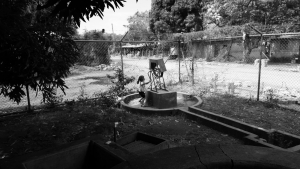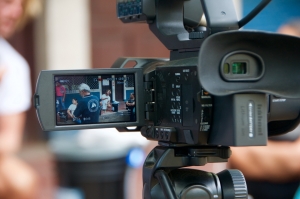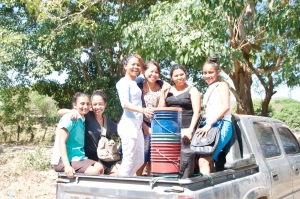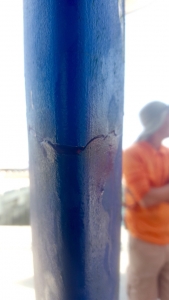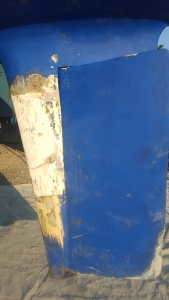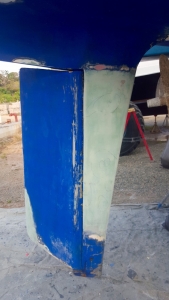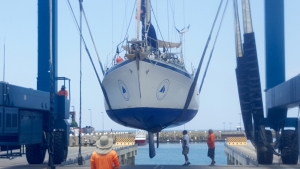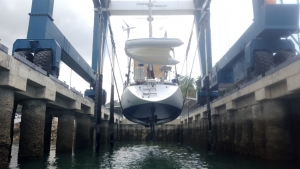
Nicaragua – Great but complicated
Few days after our crossing of the Panama Canal and with all administration requirements fulfilled, we are setting sail to Nicaragua. Located between Costa Rica and Honduras and framed by the Atlantic and Pacific oceans, we have to go through around 700 nautical miles to reach the small city of Asseradores, on the north-west coast of the country.
The journey is going to be completed by using our engine only, without wind and on an oily and shiny sea. During the day, the unmoving sea is like a vast mirror. We can now discover the Pacific Ocean and its treasures. One thing is certain: we are not alone. Dolphins, sharks, rays and all sorts of fishes including marlin and swordfish can be found in large numbers in these waters. When the night comes, a magical thing happens due to the interaction between plankton and seawater. Williwaw leaves behind us a large phosphorescent trail. We have never seen one of such intensity. Sometimes, a change in the plankton creates a new trail of colours. Seeing dolphins jumping in these phosphorescent trails is an incredible sight. For those who have seen the Life of Pi, you might have an idea of what I am talking about. For the others, just imagine the sight of the shiny shadow of a dolphin in a pitch-black ocean.
At around 150 nautical miles of our destination, a bad news arrives. We have no more oil for the engine and the wind is still absent. The problem is that we need to reach the coast as soon as possible as Pierre, our brother and cousin, is already waiting for us and will only be able to stay for few days. As the Costa Rica coast is not far, we decide to change our direction and try to reach the closest harbour to get some oil. Once again, our lack of experience will face the hard truth of long administrative issues. Indeed, in order to fill our tank, we need to enter into the country. To do so, we need to wait for the administrative office to be open. They open on Monday morning and we are Saturday afternoon, which means that we are blocked in the harbour for at least 2 or 3 days. We decide to play with luck and to use our small knowledge of sailing to take profit of the thermal winds close to the coast early at night.
The difference of temperature between the warm earth and the cooler sea creates small breezes and we would love to use them. The result is disappointing but we are lucky enough to benefit from the trade winds blowing on the large lake south of Nicaragua. Those winds will thankfully push us to the mouth of the river close to Asserradores.
We reached the entrance of the small channel leading to the marina by night, and this is where problems started. The tide is high; a good timing to enter the channel but night makes everything difficult. We contact the marina and they confirm that the channel is lit up and that we can enter. We decide to do so despite being a bit worried. The first two doors are indeed lit up and then nothing. At this time, we are using the spotlights we have on board but it is hard to have a clear sight. The water wings aren’t well positioned and we already have to fight against the decreasing tide. We progress slowly as the risk to hit a rock is high. The wind and the engine’s noise make communication between the front and the back of the boat quite difficult. We are still trying to go ahead when suddenly, we feel a strong shock. We just hit rocks. Our slow pace prevented a catastrophe but the current is now pushing Williwaw on the rocks and it becomes impossible to move it away. No one panicked. Nicolas leaves using the annex boat to ask for help at the marina. Romain goes under water to try to evaluate where the rocks are located and Thomas handles the helm. Philippe, our new crewmember, tries to provide us with some light. After few minutes, Nicolas comes back with the marina’s guard, the only human being in this isolated place. This is the beginning of a real battle to get Williwaw out of this mess. Thanks to the annex and its small 3cv engine, Nicolas push the boat on the lateral side.
Rocks in front, behind the boat and between the keel and the rudder blade block any type of movement following the axis of the boat. Romain finally succeeds to find a way out but the strength of the current increases and destroys all our efforts. After 45 minutes of an intense fight, nothing has changed and we are now only 3 hours away from the low tide, which will destroy our chances to escape without massive damages. This could mean the end of our home and of the project, unbearable for us to thing about such end.
Each of us follows its task and suddenly Williwaw moves to a new axe and with the help of its engine, gets out of this rock jail. Finally free. Once at the Marina, Pierre is finally allowed by the guards to join us. He has no idea about what just happened. As there is no trace of visible leak, we were able to celebrate our victory and family reunion.
Poorest country of the Americas after Haiti, the Nicaragua has around 6 million people, 80% of which are located on the Pacific coast. It is one of the most corrupt countries of Latin America. This situation is getting worse and worse and is visible all the way to the head of the administration and the state. The Nicaragua is the main place of transit for drugs on their way to the USA; the country has an increasing number of cartels, but surprisingly one of the lowest crime levels in Latin America. Political situation is relatively stable, even if the President Daniel Ortega, does not hesitate to run as a candidate for the presidential election, despite the country’s constitution. He was even re-elected with 62% of votes and faced a divide opposition and frauds accusations.
Nicaragua’s other characteristic is the volcanic activity. We had the chance to observe a gas explosion from the San Cristobal volcano, when travelling between Léon and Chinandega, two cities of the area. After completion of administration procedures to enter the country, we meet our local contact Marguerite, a 50 years old woman from USA, working on the ground for the development of medical help and sanitary facilities in the North West of the country. She owns a large property where she built a clinic and trains nurses from the local area. Dynamic and friendly, we are very happy to meet her and very pleased of such a warm and energetic welcome.
For a week, we are going to travel across this part of the country to meet isolated communities and bring filters to the schools and the health centres. Kindness and people’s smile are everywhere and we immediately fall in love for this country. Since we left France, it is the country where we have felt the most welcomed. We even meet a local French community, here to play their parts in the development of this country, in the touristic domain for example. Some of them are leaving on the beach, fishing daily for food, in small wood houses.
However, our mission was compromised by an unexpected event. Just before our first week, Marguerite called us and asked us to be quiet for a while. One of the local government sanitary organisations heard about our action and requested a surprise sanitary inspection at Marguerite’s clinic. After the inspection, they complained to her about our action, as we acted without warning them. They asked for the filters, probably to confiscate them. Thankfully, Marguerite told them that the mission was finished. In the middle of electoral campaign, the government was looking to benefit from this type of missions and the fine could have been severe. We quickly took the decision to leave the country before creating more problems.
We leaved Asserradores few days later, frustrated to be forced to leave so quickly. We left the last filters to Marguerite to allow her to distribute them once the danger is gone. This is only after our departure (this time without problem), that we realise the scale of the damages from our last adventure. The rudder blade is broken and we need to get the boat out of the water to repair it. We look for a marina able to help us to get the boat out. First results are worrying. We try to stop at the San Juan del Sur, south of Nicaragua, but the installations worry us even more. Thankfully our navigation adviser suggested a marina in Costa Rica, but to reach it, we need to navigate more than 200 nautical miles with a broken rudder blade. No choice, we have to give it a go.
Sail for Water is a lucky project as we managed to reach the marina without problems and we received help to start repairing the damages. After a week and many efforts under the warm Costarican weather, Williwaw is back on the water with an as-new rudder blade and the new painted dress.
We were then able to reach Panama to see our families and girlfriends after more than 6 months away. All’s well that ends well.
















